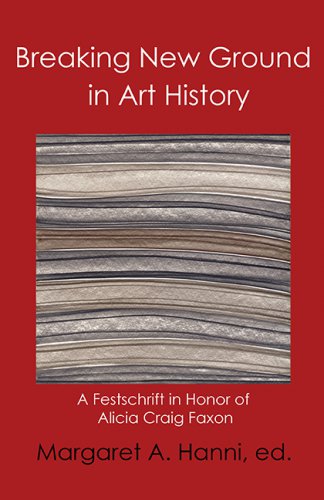
About the Author
Margaret Hanni is very fortunate to have been an undergraduate at Simmons College during the time that Alicia Faxon was Professor of Art History there, for Faxon’s mentorship and generosity began a creative academic partnership and treasured friendship that continues today. Hanni earned her Ph.D. in art history from Boston University, and served as the Director of The Lamont Gallery at Philips Exeter Academy. Her research interests eighteenth-century portraiture, the history of collections and Southeast Asian textiles. She has published articles on Mary Cassatt’s influence on collectors, Lady Emma Hamilton and has presented papers on Georgian marriage portraits, Hamilton, and Isabella Stewart Gardner. Since 1996, she has taught at Simmons College where she Chairs the Department of Art and Music.
BREAKING NEW GROUND IN ART HISTORY: A Festschrift in Honor of Alicia Craig Faxon
Margaret A. Hanni, ed.New Academia Publishing, 2014
304 Pages, 114 Illustrations
ISBN 978-0-9915047-4-9 Paperback
For BULK ORDERS, order directly from New Academia Publishing.
Queries: orders@newacademia.com
About the Author
Margaret Hanni is very fortunate to have been an undergraduate at Simmons College during the time that Alicia Faxon was Professor of Art History there, for Faxon’s mentorship and generosity began a creative academic partnership and treasured friendship that continues today. Hanni earned her Ph.D. in art history from Boston University, and served as the Director of The Lamont Gallery at Philips Exeter Academy. Her research interests eighteenth-century portraiture, the history of collections and Southeast Asian textiles. She has published articles on Mary Cassatt’s influence on collectors, Lady Emma Hamilton and has presented papers on Georgian marriage portraits, Hamilton, and Isabella Stewart Gardner. Since 1996, she has taught at Simmons College where she Chairs the Department of Art and Music.
About the book
Written in honor of Alicia Craig Faxon, Ph.D., whose career as a scholar, professor, art critic and patron of the arts has contributed so much to the fields of art history and art criticism, this collection represents recent research on a range of subjects from baroque to contemporary art. Many of the essays open new avenues through their interdisciplinary approach, such as a consideration of the Pre-Raphaelite female in contemporary fiction and an investigation into the marriages of creative couples working at the Worpswede artist colony in the early twentieth century. Visual sources and social contexts are proposed for a 1633 Rembrandt double portrait, the eighteenth-century equestrian marriage portraits of George Stubbs and for Edward Burne-Jones’ Love Song paintings of 1865-77. Scholars of American art consider the genesis of a rarely published Civil War era painting by Winslow Homer and the public reception of Maurice Prendergast’s modernity. Several essays offer insightful perspectives on facets of more recent art. The career of self-taught artist Nellie Mae Rowe is reviewed in the larger context of feminist motifs and materials, while Kathleen Gilje’s portraits of living art historians represented as earlier works of art are considered as contemporary performance. Essays by practicing artists discuss developments in silverpoint techniques from the renaissance to the present; propose a conceptual framework for viewer engagement with contemporary sculpture and trace the roots and meanings of the Fool motif in painting and performance art today. Lavishly illustrated with many images that have not previously appeared in print, Breaking New Ground offers a wide range of recent scholarship that will be of interest not only to artists and art historians, but also to scholars and students of women’s and gender studies and literature.





 Coming Soon
Coming Soon Awards
Awards